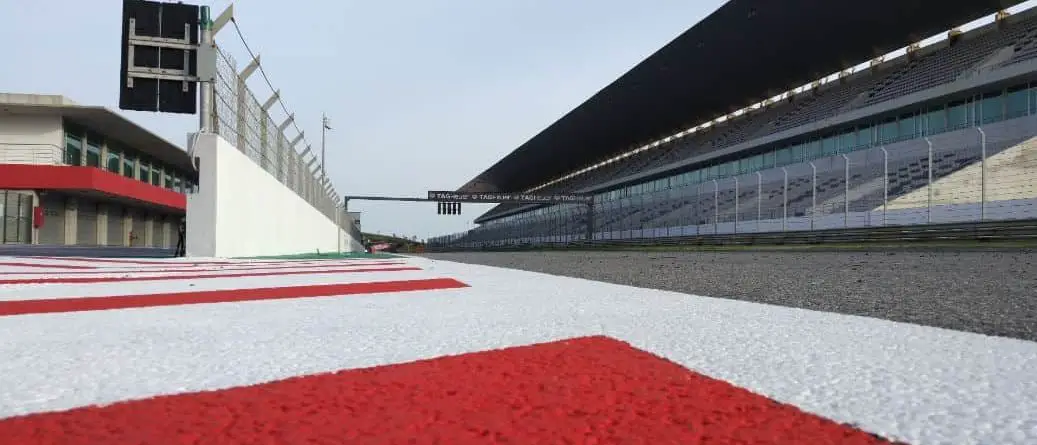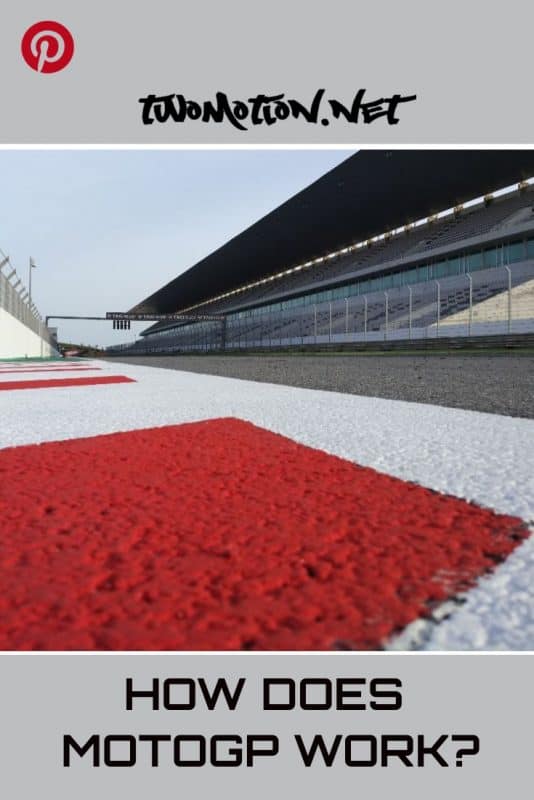MotoGP is a motorcycle championship that lays out specifications for the motorcycles and rules for the teams who participate. The championship is held at 19 different locations around the world. Teams can enter with only two riders.
Overview
In this article, we explain the basic principles of the MotoGP championship so you understand how MotoGP works.
We will discuss the following:
- What MotoGP means
- The people who organise MotoGP
- Categories
- MotoGP tracks
- MotoGP teams
- MotoGP riders
- MotoGP motorcycles
What MotoGP means
MotoGP stands for “Moto Grand Prix” which in French means “motorcycle grand prize” but could also be translated as “motorcycle great award”. It basically means that it is the great prize of motorcycling.
Translation
| French | English |
|---|---|
| Moto | Motorcycle |
| Grand | Grand/Great |
| Prix | Prize/Award |
The people who organise MotoGP
MotoGP is sanctioned by the FIM (Fédération Internationale de Motocyclisme) which is the international governing body for motorcycle sport. This means that MotoGP and many other motorcycle championships are governed by the FIM.
To find out more about the FIM, you can read the about page on their official website.
Categories
MotoGP is regarded as the top category in a series of championships. Though the general idea of racing on circuits with motorcycles are the same, there are many differences to the specifications on the motorcycles in each category.
The championship is divided into these different categories:
There are also other categories that are held to seek out new potential riders for the championships:
MotoGP tracks
There are 19 tracks/circuits on which MotoGP is held every year. But this doesn’t mean they race on the same tracks each year. A total of 69 circuits have hosted a world championship race in the past.
These are the circuits chosen for the 2020 MotoGP season:
| Circuit | Location |
|---|---|
| Circuito de Jerez-Ángel Nieto | Jerez de la Frontera, Spain |
| Circuit Bugatti | Le Mans, France |
| Mugello Circuit | Scarperia e San Piero, Italy |
| Circuit de Barcelona-Catalunya | Montmeló, Spain |
| Sachsenring | Hohenstein-Ernstthal |
| TT Circuit Assen | Assen, Nederland |
| Kymi Ring | Iitti, Finland |
| Automotodrom Brno | Brno, Czechia |
| Red Bull Ring | Spielberg, Austria |
| Silverstone Circuit | Silverstone, United Kingdom |
| Misano World Circuit Marco Simoncelli | Misano Adriatico, Italy |
| Ciudad del Motor de Aragón | Alcañiz, Spain |
| Chang International Circuit | Buriram, Thailand |
| Twin Ring Motegi | Motegi, Japan |
| Phillip Island Grand Prix Circuit | Ventnor, Australia |
| Sepang International Circuit | Sepang, Malaysia |
| Circuit of the Americas | Austin, USA |
| Autódromo Termas de Río Hondo | Termas de Rio Hondo, Argentina |
| Circuit Ricardo Tormo | Valencia, Spain |
MotoGP teams
There are currently 11 racing teams in MotoGP, each with two riders competing for the podium.
MotoGP riders
For each race, the first 15 positioned riders are awarded points. Those after 15th position in the race don’t receive any points. The scores awarded for each race counts towards winning the title of world champion in MotoGP by obtaining the most points. This scoring system has been used since 1993.
This is how points are awarded according to their position in each race:
| Position | Points awarded |
|---|---|
| 1st | 25 |
| 2nd | 20 |
| 3rd | 16 |
| 4th | 13 |
| 5th | 11 |
| 6th | 10 |
| 7th | 9 |
| 8th | 8 |
| 9th | 7 |
| 10th | 6 |
| 11th | 5 |
| 12th | 4 |
| 13th | 3 |
| 14th | 2 |
| 15th | 1 |
As said before there are two riders for each team. With 11 teams participating there is a total of 22 riders. Below is the list of riders for the 2020 MotoGP. Included are their nationalities and team names.
| Rider | Nationality | Team |
|---|---|---|
| Andrea Dovizioso | Italy | Ducati Team |
| Johann Zarco | France | Reale Avintia Racing |
| Danilo Petrucci | Italy | Ducati Team |
| Maverick Viñales | Spain | Monster Energy Yamaha MotoGP |
| Fabio Quartararo | France | Petronas Yamaha SRT |
| Franco Morbidelli | Italy | Petronas Yamaha SRT |
| Iker Lecuona | Spain | Red Bull KTM Tech 3 |
| Andrea Iannone | Italy | Aprilia Racing Team Gresini |
| Takaaki Nakagami | Japan | LCR Honda |
| Brad Binder | South Africa | Red Bull KTM Factory Racing |
| Cal Crutchlow | United Kingdom | LCR Honda |
| Joan Mir | Spain | Team Suzuki Ecstar |
| Aleix Espargaro | Spain | Aprilia Racing Team Gresini |
| Alex Rins | Spain | Team Suzuki Ecstar |
| Jack Miller | Australia | Pramac Racing |
| Pol Espargaro | Spain | Red Bull KTM Factory Racing |
| Valentino Rossi | Italy | Monster Energy Yamaha MotoGP |
| Tito Rabat | Spain | Reale Avintia Racing |
| Francesco Bagnaia | Italy | Pramac Racing |
| Alex Marquez | Spain | Repsol Honda Team |
| Miguel Oliveira | Portugal | Red Bull KTM Tech 3 |
| Marc Marquez | Spain | Repsol Honda Team |
MotoGP motorcycles
These are not stock production motorcycles you can buy like stock motorcycles. MotoGP motorcycles are specifically designed and built for MotoGP racing and set up to the needs and requirements of a specific rider according to FIM specifications.
According to sportskeeda.com, a single MotoGP motorcycle can cost around 3 to 3.5 million dollars in US currency.
MotoGP motorcycles need to comply with FIM specifications and each part is inspected by the FIM before being assembled for a race. These specifications are not the same across each category. Moto2 and Moto3 have different specifications and most obviously MotoE as well.
To find out exactly what these specifications are, you can read the official 2020 FIM GP World Championship Regulations.
Final words
MotoGP is fairly simple to understand. It’s a championship of almost 20 races over the course of around 6 months where riders need to win as many points as possible. The only thing that throws people off most of the time is the specifications of the motorcycles and some of the rules.
I always try to keep my articles interesting and informative. And I’m always thankful when they are shared on social media platforms or Pinterest.


